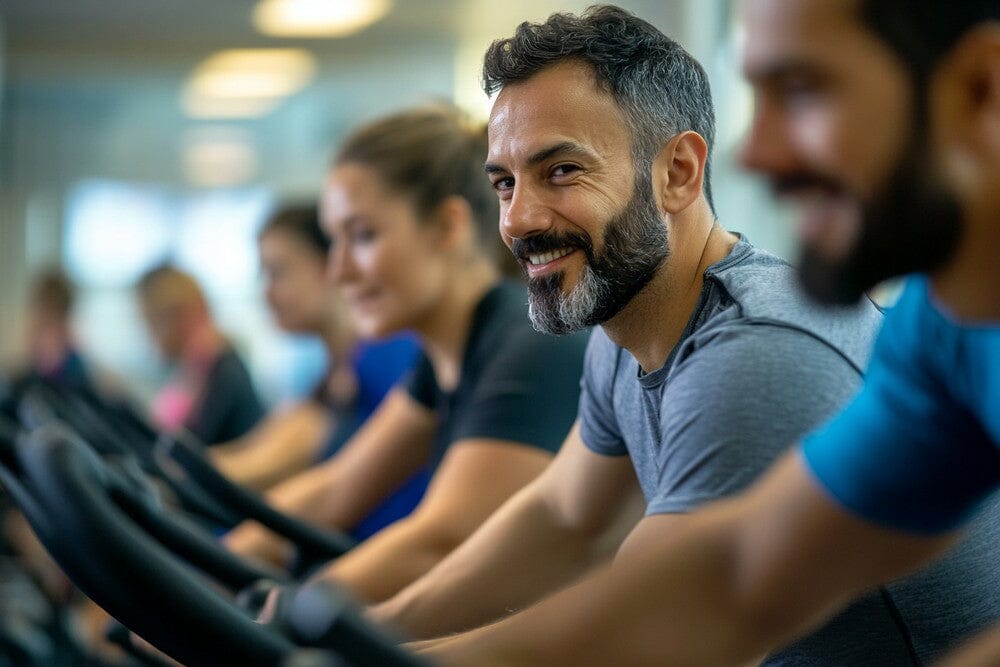A busy schedule can make it difficult to prioritize fitness, but a 15-minute workout can be a game-changer. With the right approach, you can achieve an effective full-body workout in just a quarter of an hour. This time-saving routine is perfect for all fitness levels and can easily fit into your day.
Incorporating high-intensity interval training (HIIT) into your short session increases the benefits, allowing you to build strength and endurance quickly. Whether you’re at home or at the gym, you can customize workouts based on the equipment you have and your personal fitness goals. This means you don’t have to sacrifice quality for time.
A quick and effective routine can leave you feeling energized and accomplished, proving that even a little effort goes a long way. You will learn how to structure your workouts and incorporate key elements that deliver results without requiring hours of commitment.
Key takeaways
- A 15-minute workout can effectively boost your fitness levels.
- Quick actions can include strength and endurance training.
- Customization allows you to work out with or without equipment.
Benefits of 15-minute exercise
A 15-minute workout offers significant benefits for busy lifestyles. You can maximize your time while still achieving meaningful fitness results. This section discusses its efficiency, time management and various health benefits.
Efficiency and time management
In today’s fast-paced world, finding time to exercise can be difficult. A 15-minute workout allows you to acclimate Quality exercise During a busy day.
You can easily incorporate these short sessions into your schedule, whether in the morning or during your lunch break.
These workouts usually focus on high-intensity interval training (HIIT), which increases calorie burn in a short period.
By incorporating strength training and endurance exercises, you can also effectively boost muscle strength and cardiovascular health.
Fitness and health benefits
Exercising for 15 minutes can have significant health benefits.
You can improve your cardiovascular fitness, as short periods of intense activity raise your heart rate and promote better heart health.
Moreover, these exercises can aid in weight loss due to the high calorie burning during and after exercise.
Strength and endurance training during this time frame can help build lean muscle mass and increase metabolism.
Plus, shorter workouts are often less intimidating, making it easier for you to do Stay fit Journey over time.
Overall, these short sessions can be a vital part of your fitness strategy, leading to long-term health improvements.
Basic components of a 15-minute workout
A comprehensive 15-minute workout should include elements that increase efficiency and effectiveness. Key components include incorporating high-intensity movements and a balanced approach between strength training and cardio.
High-intensity interval training
High-intensity interval training (HIIT) is vital in a short workout. It involves short bursts of Intense activity Followed by short rest periods. This method raises the heart rate quickly, which enhances the burning of calories.
Suggested HIIT exercises:
- Burpee: Combine squats, jumping jacks and push-ups for a full-body workout.
- Jump squat: Perform a squat followed by an explosive jump to target your legs and core.
Aim for 20-30 seconds of intense effort followed by 10-15 seconds of rest. You can repeat these intervals with different exercises to get an overall routine.
Strength and cardio balance
Balancing strength and cardio into a 15-minute workout boosts muscle strength and cardiovascular fitness. You can effectively target multiple muscle groups in a short time frame with functional exercises.
Main strength exercises:
- Squatting: Focus on your lower body by keeping your back straight and pushing your hips back.
- rushStep forward, keeping your front knee over your ankle to straighten your legs.
Combine these movements with cardio for an effective workout. Alternative between Strength exercises and high-intensity cardio exercises to achieve maximum benefits within a limited period of time.
Sample 15-minute workout routines
Incorporating effective exercises into a short 15-minute routine can boost your fitness without overwhelming your schedule. The following routines cater to different fitness levels, ensuring a quick and comprehensive workout.
Routine for beginners
Start with a warm-up to prepare your body. Spend 3 minutes doing dynamic stretches to increase blood flow. Follow this with:
- High knees: 30 seconds, focusing on raising your knees to hip height.
- Jumping jacks: One minute to engage the whole body.
- Push-ups: 30 seconds. Adjust to knees if necessary.
- Glute bridge: One minute, lying on your back with your knees bent. Lift your hips while squeezing your butt.
Rest for 30 seconds, then repeat this circuit again. Finish with a gentle stretch for two minutes.
Advanced full body circuit
Start with a short warm-up (2-3 minutes of jogging in place). This circuit is extensive and includes:
- High knees: One minute, aim for maximum speed.
- Jumping jacks: One minute to maintain your heart rate.
- Push-ups: 1 minute. Aim for as many reps as possible, focusing on form.
- Glute bridge: One minute, adding a single-leg variation for the challenge.
Rest for 30 seconds and repeat the circuit twice. Finish with a cool-down, including 2-3 minutes of stretching to promote recovery.
Equipment and modifications
To achieve effective results in a 15-minute workout, it’s important to consider the equipment you’re using and any modifications that could enhance your routine. You can focus on Body weight exercises Or combine weights based on your fitness level and desired intensity.
Benefit from body weight
Bodyweight exercises are accessible and require no equipment, making them perfect for a quick workout. You can perform exercises such as push-ups, squats, lunges and planks. These movements use your weight as resistance, effectively engaging multiple muscle groups.
Tips for body weight exercises:
- Form is crucial: Maintain proper technique to avoid injury.
- Increasing intensity: Try advanced variations like pistol squats or dips to challenge yourself.
- Integrating static expansion: Perform dynamic stretching before exercise and static stretching afterward to improve flexibility and reduce pain.
Combine weights
Adding weights to your routine can enhance muscle engagement and increase calorie burning. You can use dumbbells, kettlebells, or resistance bands. These tools allow for greater resistance and add intensity to exercises such as deadlifts, shoulder presses, and weighted squats.
Weighted workout considerations:
- Starting light: If you’re new to weights, choose lighter weights to perfect your form.
- Consult a specialist: Working with a certified personal trainer can help you structure your workout and choose the right weights.
- Mix it: Alternate between bodyweight exercises and weighted exercises to maintain variety and prevent stability.
After exercise
Taking time out after exercise is essential for recovery and progress. Focus on proper Cooling technologies and Track your progress To maintain motivation and results.
Cool down and stretch
Cooling down after exercise helps your heart rate gradually return to normal. Aim for 5 to 10 minutes of light activity, such as walking or slow cycling. This stage helps prevent dizziness and promote blood circulation, which is vital Muscle recovery.
After cooling down, perform stretching exercises targeting major muscle groups. Consider these extensions:
- Hamstring stretch: Hold for 20-30 seconds for each leg.
- Stretch your quadriceps: Stand on one leg while pulling the opposite heel to your buttocks.
- Shoulder stretch:Put one arm across your body, and hold it with the opposite arm.
Incorporate deep breathing during these stretches to promote relaxation.
Track progress and consistency
Tracking your progress is essential to staying motivated and seeing improvements over time. Consider using a fitness app or magazine. Record variables such as exercise duration, exercise types, and effort.
Set specific goals, which could include increasing the number of repetitions, enhancing exercise intensity, or achieving a desired physique. Regularly evaluating your progress can help you improve your routine.
Consistency is key to achieving long-term results. Create an exercise schedule that fits your lifestyle and stick to it. Remember that short, effective sessions, such as a 15-minute workout, can lead to significant improvement when done regularly.
Frequently asked questions
In this section you will find answers to frequently asked questions about 15-minute exercises. Each question addresses specific concerns and provides actionable insights to help you maximize your workout efficiency.
What are the best exercises to include in a 15-minute workout for beginners?
For beginners, focus on bodyweight exercises such as squats, push-ups, lunges and planks. It can be adjusted to suit your fitness level. Incorporating short cardio exercises, such as jumping jacks or high knees, can improve your routine as well.
How can I design an effective 15-minute workout at home without any equipment?
To design a no-equipment workout, select a set of bodyweight exercises that target different muscle groups. Organize it in a circuit, performing each exercise for 30 seconds followed by a 15-second rest. Repeat the circuit until the 15 minutes are complete.
What kind of results can I expect from exercising for 15 minutes every day?
With daily 15-minute workouts, you can expect improvements in endurance, strength and overall fitness. While visible Weight loss It may take some time, and consistency will improve muscle strength and increase energy levels.
Is exercising for 15 minutes enough to lose weight significantly?
While a 15-minute workout can contribute to weight loss, significant results depend on additional factors such as diet and overall activity level. Combining short exercises with healthy eating will supercharge your weight loss efforts.
How can I intensify a 15-minute workout when using weights?
To intensify your weight training, increase the weight or resistance used in your exercises. You can also reduce rest times between sets or increase the number of repetitions of each exercise to maintain a higher heart rate.
Are there benefits to doing a 15-minute standing exercise versus a traditional exercise?
Standing exercises can promote balance and engage the core muscles more effectively. They may also be easier on the joints than floor exercises. Incorporating standing movements keeps your energy levels higher and can increase your calorie burn.

